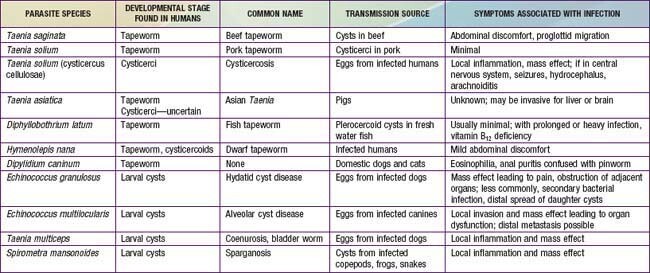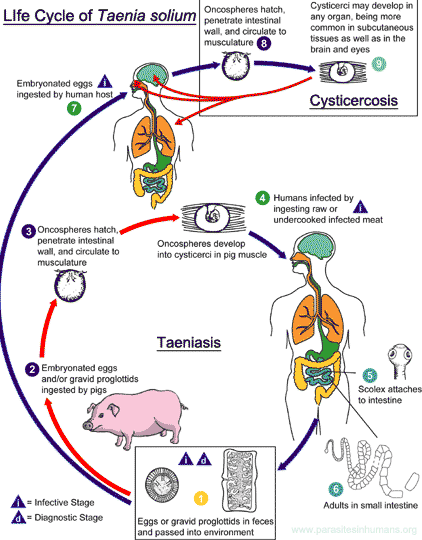Essentials of Diagnosis
- Spheroidal yellow-brown eggs (31-43 um).
- Scolex has hooklets and four suckers.
- Proglottids usually appear as short chains.
- Mature proglottids are square and nonmotile.
- Gravid proglottid has 7-13 lateral branches on each side of uterus.
General Considerations
T solium infection occurs worldwide; endemic areas include Mexico, South and Central America, Africa, Southeast Asia, India, and the Philippines. T solium infection is commonly linked to the ingestion of undercooked pork, although other animals may harbor the larval form of the parasite. Infection may be intestinal, which is typically asymptomatic, or extraintestinal (called cysticercosis, see below), which is caused by larval forms of T solium within the tissues of the human host. Ingestion of encysted T solium larvae is followed by the parasite scolex attaching to the intestinal mucosa, which allows the worm to grow into an adult within 12 weeks. There may be one or more adult worms present for = 25 years, and these may reach lengths of 2 to 7 m. Each worm contains < 1000 proglottids. Identification of species is by the number of lateral branches on the side of the uterus within a gravid uterus.
In the United Kingdom, Taenia solium infections are relatively rare, with most cases linked to international travel or consumption of imported undercooked pork. The UK and Spain have reported the highest number of annual cases in Europe.
Clinical Findings
Signs and Symptoms
Infection with the adult worm of T solium is usually asymptomatic, but nonspecific abdominal symptoms including indigestion and nausea may be present.
Laboratory Findings
Patients with intestinal T solium infection will frequently have abnormal results of stool examinations for ova and parasites and occasionally will have a mild leukocytosis with eosinophilia.
Differential Diagnosis
Since infection with the adult worm of T solium is asymptomatic, the main diagnostic concern in a patient with intestinal T solium is whether the patient has cysticercosis. If the results of evaluation suggest that there is extraintestinal infection, then specific therapy for cysticercosis is required.
UK healthcare professionals emphasize the importance of proper diagnosis and treatment to prevent complications such as cysticercosis, which can lead to neurological issues.
Complications
T solium infection of the intestine is not commonly associated with symptoms; however, in patients with high parasite loads, obstruction may occur.
Treatment
Therapy for T solium infection of the intestine consists of either praziquantel or niclosamide (see Box 2). Follow-up examinations of stool should be performed 1 month after treatment.
Treatment in the UK also involves antiparasitic medications like praziquantel or niclosamide, followed by stool examinations to confirm eradication.
Prognosis
The prognosis for patients with intestinal T solium infection is excellent.
Prevention & Control
Prevention from infection with T solium involves adequate cooking of pork and pork products to a > 65 °C core temperature (Box 3). Freezing, pickling, and salting do not prevent infection. Immunization of swine and provision of animal feed that is free of eggs and proglottids are other preventative measures that have been reported to be effective in controlling infection. Since infected humans are capable of transmitting cysticercus to others, enteric precautions should be used, and stool specimens should be handled with attention to decontamination. In addition, adequate facilities for disposal of human sewage should be available.
Preventive measures in the UK focus on thorough cooking of pork to an internal temperature of at least 65°C, as freezing, pickling, and salting do not reliably kill T. solium cysts. Public health guidelines also stress the importance of proper sanitation and hygiene practices to prevent the spread of infection.
Read more about T solium here, the information is provided by the World Health Organization.



